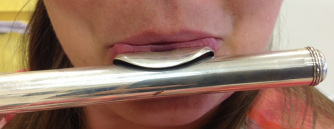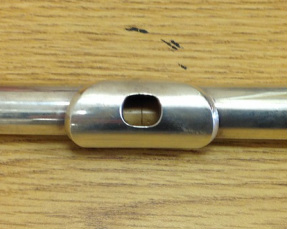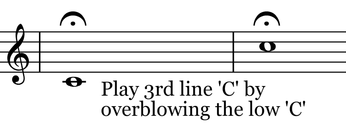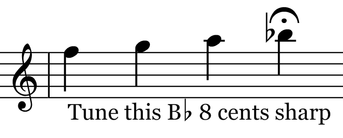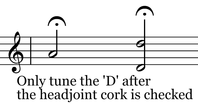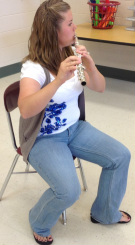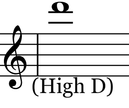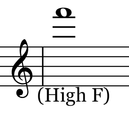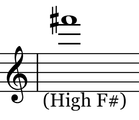DISCLAIMER: The quality of equipment (instrument, head joint) has a very big impact on intonation. If the equipment is not in working order, the information and techniques on this webpage will not be as effective.
Embouchure Check!Your embouchure formation can either help or hurt your pitch accuracy. Here is a brief reminder about how you should form your embouchure:
|
Check Your Headjoint Cork!To make sure that your headjoint cork is in the correct position, take your tuning rod (the opposite side is used for swabbing out the instrument) and put it into your headjoint. The line on this rod should be in the center of the embouchure hole. Adjust the cork placement by turning the headjoint cap to the right (pulls the cork out and moves the rod line to the left) or turning the cap to the left and pushing in. This loosens the cap. So, to adjust the cork, push the cap in. This will move the cork further into the flute and move the line to the right.
|
How To Tune The Flute
Once you have checked to make sure that you are forming your embouchure correctly, follow this procedure for tuning your instrument:
1) Play your instrument for a few minutes to warm up your embouchure muscles and your flute.
5) Then, play 2nd space 'A' with your best tone at a mezzo-forte dynamic.
This note should require little to no adjustment.
This note should require little to no adjustment.
Ways to Adjust the Flute While Playing
Even after tuning our instrument, there will still be notes that are naturally out-of-tune for various reasons. This makes it necessary for us to adjust, or manipulate, the pitch while playing. Here are some simple ways to adjust pitch:
Air Direction
|
Vowel Shape
|
**Avoid thinking "Roll-In" or "Roll-Out" to adjust pitch. This changes your hand position in addition to covering far too much or too little of the embouchure hole. The more the embouchure hole is covered, the less dynamic range the flute has. The flute is already an instrument with limited dynamic range, and rolling in or out can be a detriment to tone and volume. Instead of "Rolling-In" or "Rolling-Out," think about adjusting air stream direction.***
Other Factors That Effect Flute Intonation
Pressing Flute Into Bottom Lip/ChinPressing the flute too hard into the bottom lip will cause the flutist to cover too much of the embouchure hole, causing them to play under pitch.
Breath Support/Air SpeedBreath support and air speed greatly effects intonation. When breath support is not strong enough, intonation will tend to be flat. This can lead to the player attempting to compensate for for the bad intonation by developing other bad habits (such as too much tension in the embouchure or directing air too far up or down). When the breath support/air speed is too strong, pitch will tend to go sharp. Adjusting the aperture size will also effect air speed.
Pads and KeysKey alignment effects intonation. Certain notes can be airy and weak due to leaking keys. Many of the keys that you do not directly press will become leaky over time (Bb keys, keys between G and F, etc.). Have your flute aligned and adjusted once per year by a qualified technician.
|
Posture
TemperatureWhen the temperature is hot, the flute pitch will be sharp. When the temperature is cold, the flute pitch will be flat. Playing the flute at room temperature will give you the best chance of being in tune.
|
PITCH TENDENCIES
Every instrument has notes that are naturally out of tune. Here is a list of common naturally out-of-tune notes for the flute along with ways to correct their pitch:
Slightly Flat Note |
Common Fingering |
Alternate Fingering to Improve
|
Flute Intonation Videos
|
This is a video about alternate fingerings:
|
General Flute Intonation Video:
|
This is a video about adjusting the cork of the headjoint:
|
